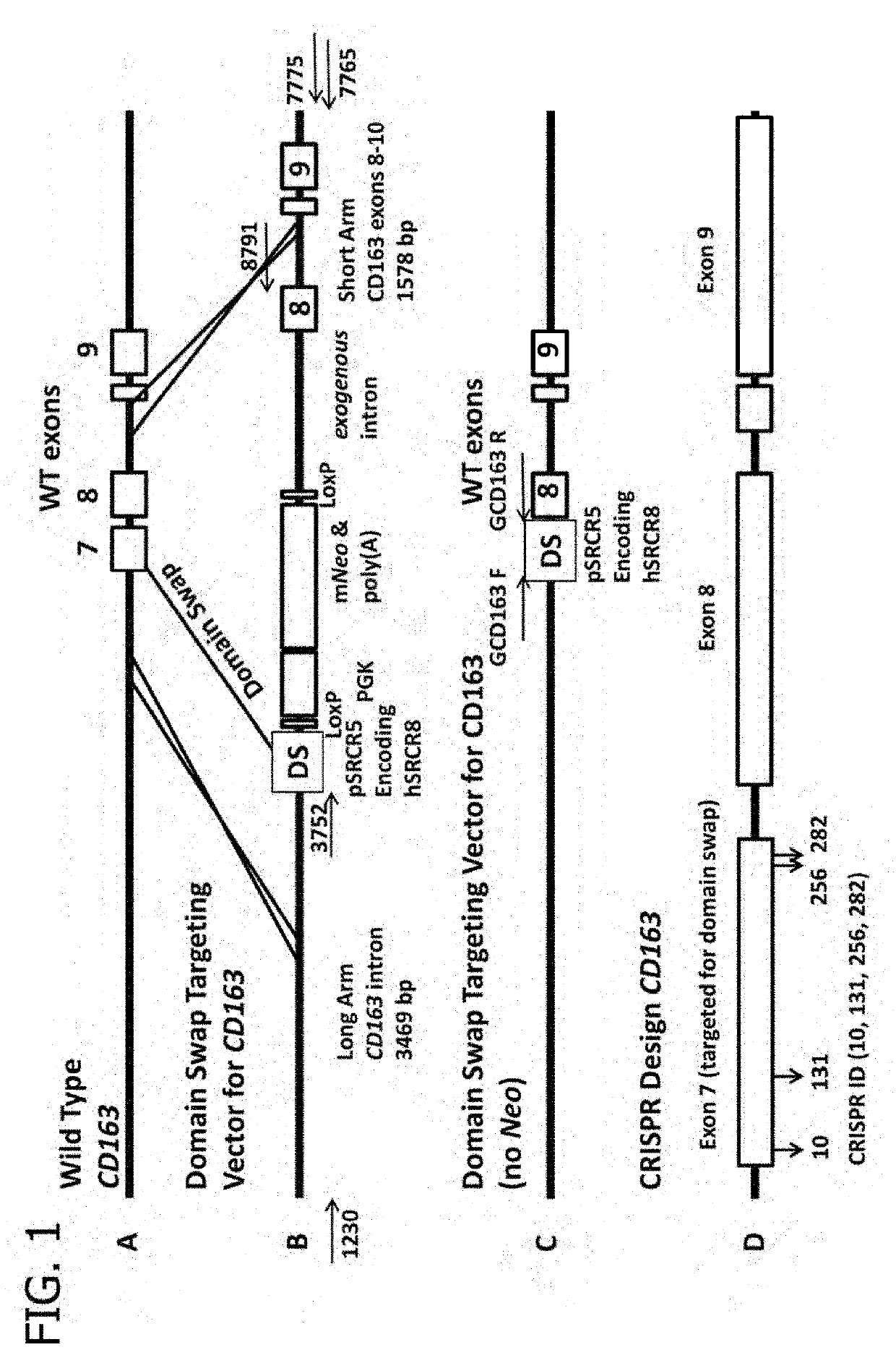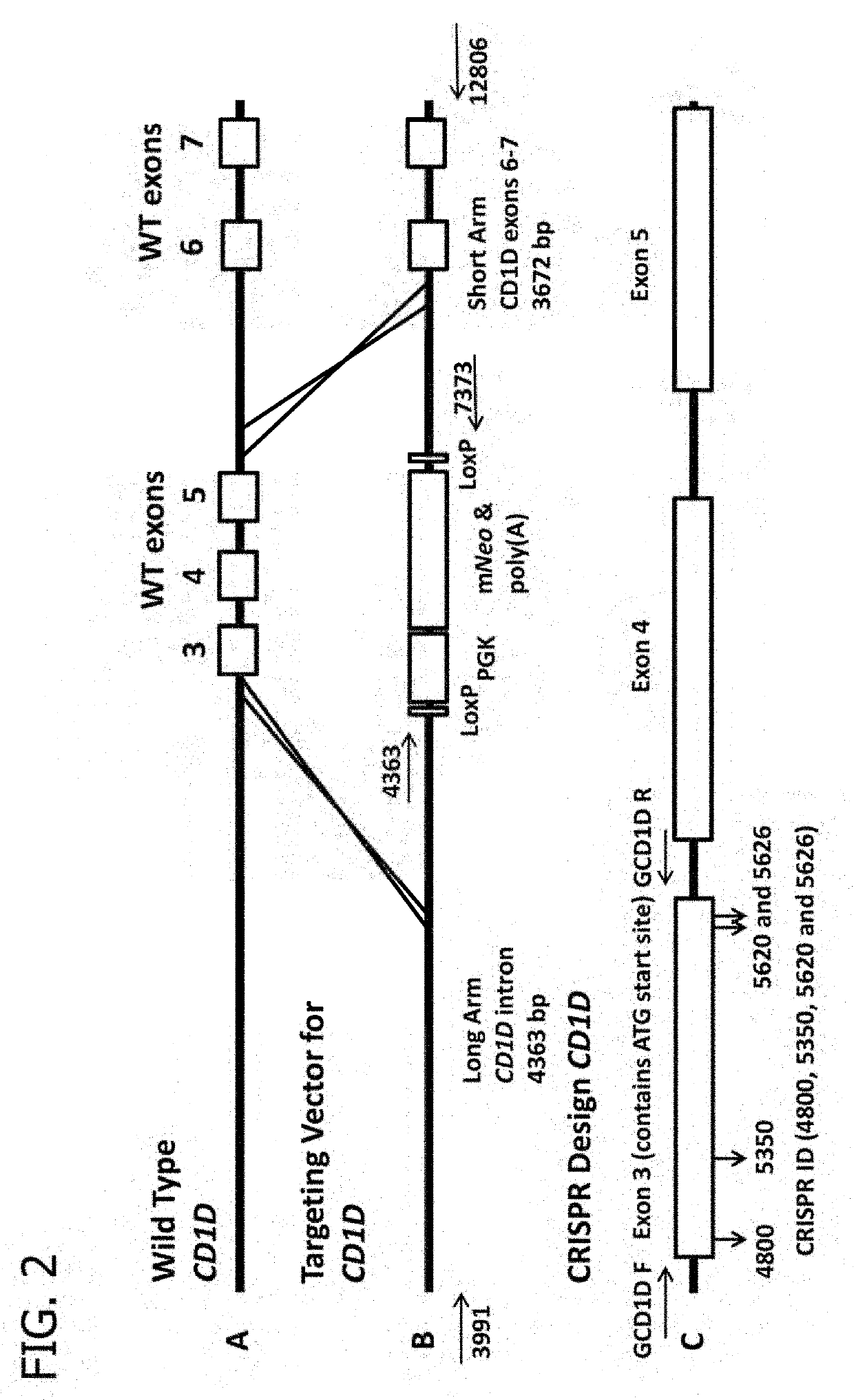Methods for protecting porcine fetuses from infection with porcine reproductive and respiratory syndrome virus (PRRSV)
a technology of porcine reproductive and respiratory syndrome and porcine fetuses, which is applied in the direction of viruses/bacteriophages, animal/human proteins, peptides, etc., can solve the problems of high mortality of fetuses/neonates, increased mortality of dams, so as to reduce the susceptibility of female porcine animals to infection
- Summary
- Abstract
- Description
- Claims
- Application Information
AI Technical Summary
Benefits of technology
Problems solved by technology
Method used
Image
Examples
example 1
Use of the CRISPR / Cas9 System to Produce Genetically Engineered Pigs from In Vitro-Derived Oocytes and Embryos
[0238]Recent reports describing homing endonucleases, such as zinc-finger nucleases (ZFNs), transcription activator-like effector nucleases (TALENs), and components in the clustered regularly interspaced short palindromic repeat (CRISPR) / CRISPR-associated (Cas9) system suggest that genetic engineering (GE) in pigs might now be more efficient. Targeted homing endonucleases can induce double-strand breaks (DSBs) at specific locations in the genome and cause either random mutations through nonhomologous end joining (NHEJ) or stimulation of homologous recombination (HR) if donor DNA is provided. Targeted modification of the genome through HR can be achieved with homing endonucleases if donor DNA is provided along with the targeted nuclease. After introducing specific modifications in somatic cells, these cells were used to produce GE pigs for various purposes via SCNT. Thus, hom...
example 2
Increased Resistance to PRRSV in Swine Having a Modified Chromosomal Sequence in a Gene Encoding a CD163 Protein
[0270]Porcine Reproductive and Respiratory Syndrome Virus (PRRSV) has ravaged the swine industry over the last quarter of a century. Speculation about the mode of viral entry has included both SIGLEC1 and CD163. While knockout of SIGLEC1 did not affect the response to a viral challenge, it is shown in the present example that CD163 null animals show no clinical signs of infection, lung pathology, viremia or antibody production that are all hallmarks of PRRSV infection. Not only has a PRRSV entry mediator been confirmed; but if similarly created animals were allowed to enter the food supply, then a strategy to prevent significant economic losses and animal suffering has been described.
Materials and Methods
[0271]Genotyping was based on both DNA sequencing and mRNA sequencing. The sire's genotype had an 11 bp deletion in one allele that when translated predicted 45 ...
example 3
Increased Resistance to Genotype 1 Porcine Reproductive and PRRS Viruses in Swine with CD163 SRCR Domain 5 Replaced with Human CD163-Like Homology SRCR Domain 8
[0287]CD163 is considered the principal receptor for porcine reproductive and respiratory syndrome virus (PRRSV). In this study, pigs were genetically edited (GE) to possess one of the following genotypes: complete knock out (KO) of CD163, deletions within CD163 scavenger receptor cysteine-rich (SRCR) domain 5, or replacement (domain swap) of SRCR domain 5 with a synthesized exon encoding a homolog of human CD163-like (hCD163L1) SRCR 8 domain Immunophenotyping of porcine alveolar macrophages (PAMs) showed that pigs with the KO or SRCR domain 5 deletions did not express CD163 and PAMs did not support PRRSV infection. PAMs from pigs that possessed the hCD163L1 domain 8 homolog expressed CD163 and supported the replication of Type 2, but not Type 1 genotype viruses. Infection of CD163-modified pigs with representative Type 1 and...
PUM
| Property | Measurement | Unit |
|---|---|---|
| volume | aaaaa | aaaaa |
| pH | aaaaa | aaaaa |
| pH | aaaaa | aaaaa |
Abstract
Description
Claims
Application Information
 Login to View More
Login to View More - R&D
- Intellectual Property
- Life Sciences
- Materials
- Tech Scout
- Unparalleled Data Quality
- Higher Quality Content
- 60% Fewer Hallucinations
Browse by: Latest US Patents, China's latest patents, Technical Efficacy Thesaurus, Application Domain, Technology Topic, Popular Technical Reports.
© 2025 PatSnap. All rights reserved.Legal|Privacy policy|Modern Slavery Act Transparency Statement|Sitemap|About US| Contact US: help@patsnap.com



